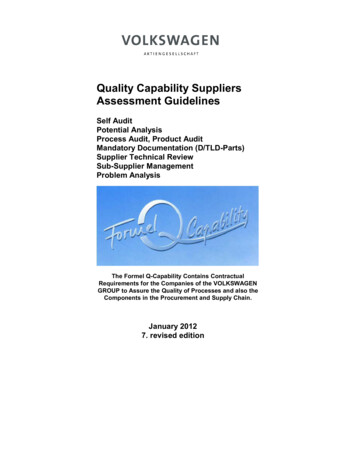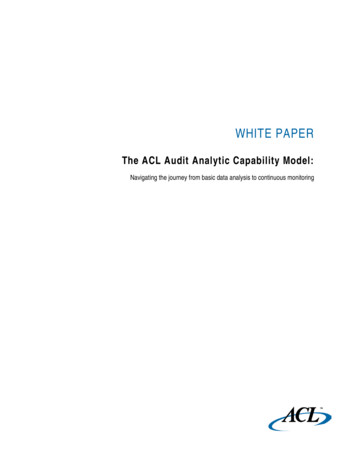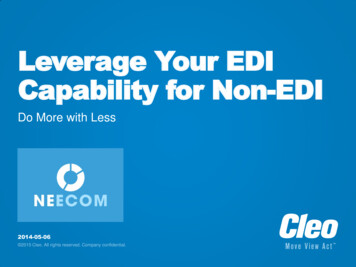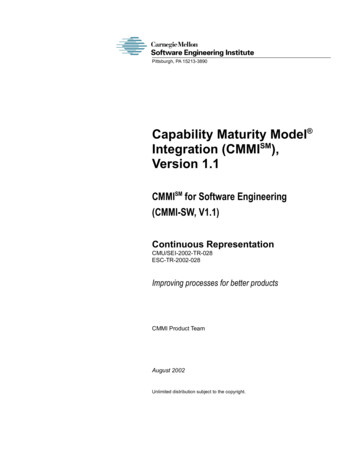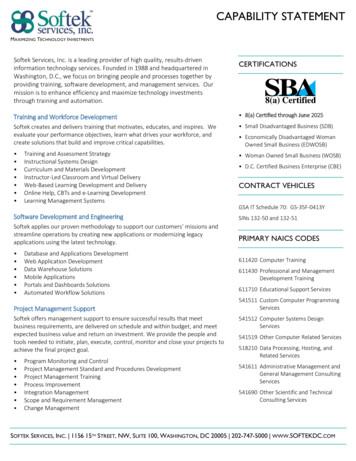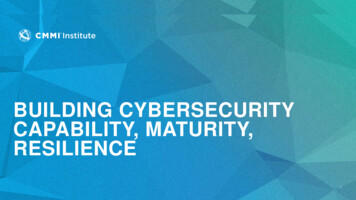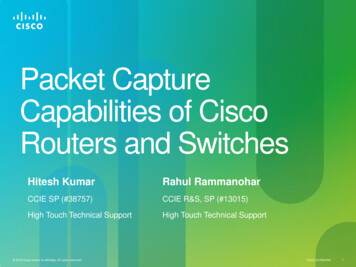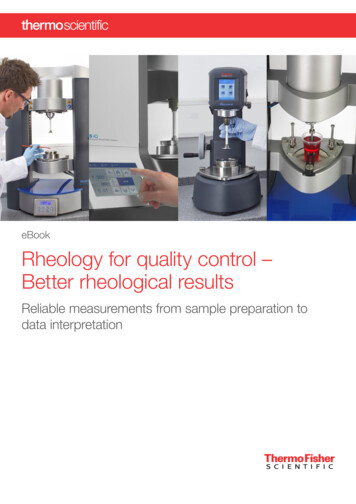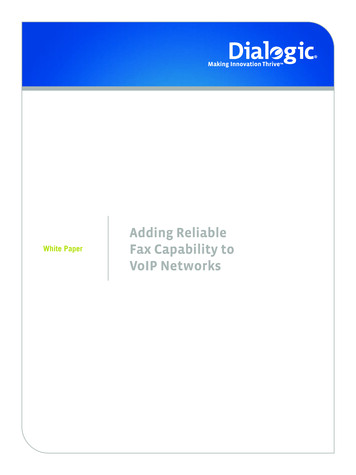
Transcription
Small LogoWhite PaperAdding ReliableFax Capability toVoIP Networks
Adding Reliable Fax Capability to VoIP NetworksWhite PaperExecutive SummaryAs businesses move to Voice over IP (VoIP), they often neglect to consider that traditional fax technology was notdesigned to work on VoIP networks. In addition, IP-PBX vendors, VARs, and Systems Integrators tend to dismiss faxas an obsolete technology, even though studies show that significant growth in the fax market is expected during thenext five years. Because fax is not “going away” in the foreseeable future, it is important to implement fax efficientlyand reliably on a VoIP network. This white paper will compare the two principal options for implementing fax in aVoIP network today: Fax-Relay (T.38) and Fax Pass-Through (G.711) and will conclude that Fax Relay is superior.Adding a Fax over IP (FoIP) fax server and Multi-Function Peripherals (MFPs) to the IP network infrastructure canalso provide gains in productivity and streamlined regulation compliance along with the additional benefit of reducingmaintenance and administration.
Adding Reliable Fax Capability to VoIP NetworksTable of ContentsFax in the VoIP Network Today . . . . . . . . . . . . . . . . . . . . . . . . . . . . . . . . . . . . . . . . . . . . . . . 2Interest in Fax over IP and the Fax Market . . . . . . . . . . . . . . . . . . . . . . . . . . . . . . . . . . . . . . . 2Traditional T.30 Fax . . . . . . . . . . . . . . . . . . . . . . . . . . . . . . . . . . . . . . . . . . . . . . . . . . . . . . . . 2Fax Solutions for VoIP . . . . . . . . . . . . . . . . . . . . . . . . . . . . . . . . . . . . . . . . . . . . . . . . . . . . . . 2Fax Pass-Through . . . . . . . . . . . . . . . . . . . . . . . . . . . . . . . . . . . . . . . . . . . . . . . . . . . . 2Fax Relay . . . . . . . . . . . . . . . . . . . . . . . . . . . . . . . . . . . . . . . . . . . . . . . . . . . . . . . . . . . 3Fax Pass-Through vs. Fax Relay . . . . . . . . . . . . . . . . . . . . . . . . . . . . . . . . . . . . . . . . . . 3A Summary of Advantages of Fax Relay vs. Fax Pass-Through . . . . . . . . . . . . . . . . . . . 4Additional Advantages of Fax Relay over Fax Pass-Through . . . . . . . . . . . . . . . . . . . . . 4Fax Servers and MFPs . . . . . . . . . . . . . . . . . . . . . . . . . . . . . . . . . . . . . . . . . . . . . . . . . . . . . 4Fax Servers . . . . . . . . . . . . . . . . . . . . . . . . . . . . . . . . . . . . . . . . . . . . . . . . . . . . . . . . . 4MFPs . . . . . . . . . . . . . . . . . . . . . . . . . . . . . . . . . . . . . . . . . . . . . . . . . . . . . . . . . . . . . . 4Advantages of Fax Servers . . . . . . . . . . . . . . . . . . . . . . . . . . . . . . . . . . . . . . . . . . . . . . 5Dialogic Brooktrout Fax Products and Fax Server Applications . . . . . . . . . . . . . . . . . . . . . . . 5 Using Dialogic Media Gateways in FoIP Solutions . . . . . . . . . . . . . . . . . . . . . . . . . . . . . . . . . 5 References . . . . . . . . . . . . . . . . . . . . . . . . . . . . . . . . . . . . . . . . . . . . . . . . . . . . . . . . . . . . . . 6Acronyms . . . . . . . . . . . . . . . . . . . . . . . . . . . . . . . . . . . . . . . . . . . . . . . . . . . . . . . . . . . . . . . 6For More Information . . . . . . . . . . . . . . . . . . . . . . . . . . . . . . . . . . . . . . . . . . . . . . . . . . . . . . 71White Paper
Adding Reliable Fax Capability to VoIP NetworksFax in the VoIP Network TodayWhite Paperfax protocol was designed for a network with relatively smoothand uninterrupted data flows, which is the opposite of theway in which an IP network behaves. In other words, the T.30fax protocol was not created to tolerate the latency, jitter, andpacket loss that are inherent in an IP network.With IP line shipments exceeding 50% of new PBX andcontact center technology since 2005 in some regions, theconvergence of voice and data on a single network is obviouslymoving forward at a healthy pace [Synergy]. But as the adoptionof VoIP continues, the fact that traditional fax technology isproving less suitable for implementation on a VoIP networkthan on a TDM network is often ignored by IP-PBX vendors,VARs, and Systems Integrators. The feeling seems to be thatfax will be “going away” soon, and the interim techniques ofconnecting a few fax machines to a new VoIP network with anAnalog Telephone Adaptor (ATA) or maintaining a few POTSlines for fax are sufficient. The common belief seems to bethat, for the short term, an 80% to 90% single page successrate for fax transmission can be tolerated, even though theinefficiency resulting from a strategy that provides such apoor success rate can be sizeable, resulting in significantlyhigher toll charges, lost time and productivity, poor networkperformance, and a lower level of customer service.Second, the compression routinely implemented by VoIPnetworks works well for speech (based on the limited frequencyresponse of the human ear and the human brain’s ability to “fillin the gaps” when certain sounds are missing from a spokenwords), but the distortion resulting from compression andpacketization can easily cause a T.30 transmission to fail.Third, the overall variability and unpredictability of an IPnetwork (the internet in particular) makes it nearly impossibleto “tune” a T.30 session to deal with IP network behavior. Inaddition, fax transmissions that complete when an IP networkis lightly loaded may fail when the same network is moreheavily loaded. The opposite is also true. If a system is tunedto complete faxes successfully when it is heavily loaded, a highfax failure rate may result when the network is lightly loaded.Fax is not conveniently fading away, and studies continue toindicate that fax technology will continue to be a major part ofthe telecom infrastructure for many years to come. A judiciousstrategy, then, seems to be to move fax to the IP infrastructurein order to fully realize the financial and administrative benefitsof the converged network.Fax Solutions for VoIPTo create an environment for more reliable fax transmissionover a VoIP network, the industry has adopted two solutions:Fax Pass-Through and Fax Relay.Fax Pass-ThroughThis paper examines and compares the options available foradding fax traffic to a converged voice and data network. Inaddition, it will consider the benefits of adding a fax server toa converged network as well as those derived from includingMulti-Function Peripherals (MFPs).Fax Pass-Through is a simple technique for creating a “faxfriendly” environment on a VoIP network. Its biggest drawbackis that it makes very little distinction between voice calls andfax calls. Also called Voice Band Data (VBD) by the ITU,Fax Pass-Through refers to the transport of fax or modemsignals over a voice channel through a packet network withan encoding appropriate for fax or modem signals. Theminimum set of coders for Fax Pass-Through mode is G.711(µ-law and A-law) with Voice Activity Detection (VAD) andEcho Cancellation (EC) disabled.Interest in Fax over IP and the Fax MarketDiscussions of methods for achieving real-time fax transmissionover a VoIP network is a topic of interest in the industry, as canbe seen repeatedly in the blog of Tom Keating, CTO at TMC[Keating]. At the same time, significant growth is expected inmany segments of the fax market in the next five years. Forexample, the Fax over IP Fax Server segment is expected toshow a Compounded Annual Growth Rate (CAGR) of 39.2%through 2011 and be worth 340 million. [Davidson]Two methodologies are used for implementing Fax PassThrough. In the first, a dedicated “fax trunk” is createdby configuring all ATAs, IADs, and gateways to be lockedpermanently at G.711 with VAD and EC disabled. While thissetup may be acceptable in a small office where a “dedicatedfax line” is normally available, having a dedicated fax trunkis far more expensive and severely restricts the ability ofTraditional T.30 FaxTraditional real-time faxing (T.30) is inadequate and unreliableover a VoIP Network for a number of reasons. First, the T.302
Adding Reliable Fax Capability to VoIP NetworksWhite Papertelecom administrators to take advantage of any trunksharing capabilities available with the PBX or IP-PBX in theirinfrastructure.For the study, a test environment was set up that consisted ofthe following:A second, more elegant methodology is to install gatewaysthat are able to distinguish between a voice call and a faxcall in real time by detecting the V.21 preamble, which is partof all fax calls. Once this preamble is detected, the gatewayautomatically switches to Fax Pass-Through mode [Haynes]. Two FoIP-capable gateways Two G3 fax machinesAll four devices were connected on a network and signals werepassed through a TDM Exchange. A packet-based networkemulation device was present in the environment.A one-page fax document was sent between the two faxmachines while varying delay, jitter, and packet-loss in thepacket network. Tests were made with the gateways in bothFax Pass-Through and Fax Relay modes and also with avariety of packetization speeds. In addition, T.38 was testedin both redundant and non-redundant configurations. Theimage quality, transmission time, and success rate weremeasured [Aljaz].The disadvantage of Fax Pass-Through mode is that itprocesses fax calls as audio calls. The tones that the sendingfax machine generates are transmitted as accurately as possiblethrough the network until they are “heard” by the receiving faxmachine; however, no effort is made by the network, or anynetwork element, to interpret the tones. All tone interpretationis left to the endpoint (receiving) fax device. Any distortionor disruption of the tones during transit across the networknegatively impacts the quality of the fax transmission.DelayThe effects of fixed delay were nominal on both image qualityand success rate. The test page was sent with nearly a100% success rate in both Fax Pass-Through and Fax Relaymode with no image distortion. Increasing delay did resultin measurably longer transmission times (as much as 15%longer transmission times with 500 ms of network delay).Delay increased transmission time more significantly in FaxRelay Mode than it did in Fax Pass-Through mode.Fax RelayUnlike Fax Pass-Through, Fax Relay breaks down the T.30fax tones into their HDLC frames (known as demodulation)before sending the fax information through the network. Thisinformation is sent across the voice network using the T.38 FaxRelay protocol, and is then converted back into T.30 fax tonesat the endpoint (known as modulation). The fax machines oneither end are sending and receiving tones and are not awarethat any demodulation or modulation is occurring.Packet LossFax Pass-Through vs. Fax RelayThe effects of packet loss were much more pronounced. At1% packet loss, single-page success rate fell to below 80%for every configuration except for Fax Relay in redundantmode. The success rate for Fax Relay in redundant moderemained above 80% until packet loss exceeded 4%. Whilean 80% success rate may be acceptable for a single page,a fax document greater than 20 pages has less than a 1%chance of successful delivery at that throughput level. A55-page fax theoretically cannot be delivered (statistically tothree significant digits).Although it seems obvious that Fax Relay is superior to FaxPass-Through, have any studies been done to definitivelydecide the issue? Since delay, jitter, and packet loss are socritical to Quality of Service and VoIP performance, a detailedstudy was published in 2007 in which the impact of each wasrecorded and compared. [Aljaz]In Fax Pass-Through mode, no distinction could be madebetween the effects of random packet loss and bursty packetloss. However, in Fax Relay mode, bursty packet loss (inwhich more than 10 packets in a row are lost), will significantlyimpact the success rate even when fax transmission is inredundant mode.T.38 is an ITU protocol that is designed to enable faxtransmission over IP networks in real time. It was engineeredto deal with the characteristics of an IP network, which canmake standard T.30 faxing unreliable over IP. In short, theT.38 standard uses a variety of techniques that keep the T.30communication between two T.30 endpoints from failing wheneven significant delay, jitter, and packet-loss occur.3
Adding Reliable Fax Capability to VoIP NetworksWhite PaperJitterBandwidthThe effect of jitter (variable delay) is normally very significant,but introducing jitter into the test network had no effect whensending faxes via Fax Relay. Fax Pass-Through was verydifferent. With a nominal delay of 60 ms and the maximumlength of the jitter buffer set to 100 ms, the success rate forfaxes sent using Fax Pass-Through fell to below 80% with delayvariance of as little as 17 ms in some configurations. Otherconfigurations did stay at about an 80% success rate until thevariance reached 25 ms. Success rate in Pass-Though modeincreased when the maximum size of the jitter was set equal tothe expected nominal delay. Increasing the maximum lengthof the jitter buffer to match the nominal delay had a negativeeffect on the quality of the voice conversations carried over theconverged network.When transmitting the same fax over an IP network, thebandwidth for Fax Relay is 20% of the amount needed for FaxPass-Through. Fax Relay is a T.38 fax transmission that usesa stream of bits running at an average speed of 14,400 bps.Fax Pass-Through is a G.711 stream of audio samples runningat 64,000 bps. Using Fax Relay can result in a bandwidthsavings of 80% over Fax Pass-Through.CODEC SupportWhen deciding between Fax Relay and Fax Pass-Through, itis important to check whether or not a network provider stillsupports the older technology of G.711. Because they need tomaximize available bandwidth, network providers may chooseto drop support for G.711 and may only support T.38 becauseof its superior bandwidth efficiency.Fax Relay Merits Serious ConsiderationFax Servers and MFPsTaken as a whole, the research cited here indicates that FaxRelay is more reliable than Fax Pass-Through. Because packetloss and jitter are present on most networks, adopting FaxRelay should be given serious consideration, since Fax PassThrough may not provide the QoS required for many businessfax applications.As they search for the right strategies for reducing costs,increasing productivity, eliminating operational risks, andcomplying with the rapidly changing regulatory environment,many enterprises are integrating fax servers, MFPs, andfax document management systems as solutions to thesechallenges.A Summary of Advantages of Fax Relay vs. Fax PassThroughFax ServersFax servers support centralized faxing services for networkconnected nodes. Today’s fax servers sit at the center of verybusy and complex networks of users, business applications,and communications technologies, and can perform a widevariety of value-added services while automating the timeintensive process of sending and receiving faxes. A centralcomponent of document management systems, fax serversprovide fax document management services and performa range of tasks. They can complete simple tasks, such asappending fax cover pages and dialing fax numbers, and morecomplex ones that include automating fax invoices generatedby ERP systems, and routing incoming faxes to recipients andto applications that serve as a conduit for records managementand workflow.When attempting to send real-time faxes over an IP networkthat is operating under normal conditions, a success rate of80% is reasonable for single-page faxes. Unfortunately, an80% success rate for faxes over four pages may cause themto fail. Fax documents of over 20 pages have less than a 1%chance of successful completion. The implementation of FaxRelay (T.38 protocol) in redundant mode can provide a successrate of upwards of 98% for one-page faxes even with a delayof up to 500 ms, packet loss of up to 4%, and significant jitter.Fax Pass-Through (G.7.11) does not provide an equivalentsuccess rate, partly because G.711 is not a specialized faxprotocol, but a voice protocol.Additional Advantages of Fax Relay over Fax PassThroughMFPsWhen deciding between Fax Relay and Fax Pass-Through, twoother areas to consider are bandwidth and CODEC support.The addition of MFPs can further enhance the overall valueof a fax solution because they allow user documents to be4
White PaperAdding Reliable Fax Capability to VoIP Networksor IP faxes at speeds of up to 33.6 kbps. Not only can theBrooktrout TR1034 process fax at twice the speed of 14.4kbps fax boards, but it also supports V.8 fast handshaking andadvanced compression, which can cut call setup and sessionmanagement time by one-third. A document that can be faxedin one minute with a 14.4 kbps intelligent fax board can be sentin less than 30 seconds with the Brooktrout TR1034. This cantranslate into significant savings on long-distance toll charges.captured electronically by the fax document managementsystem without requiring modifications to standard workroutines. If staff members are comfortable with using traditionalfax machines, the introduction of MFPs can maintain standardoperating procedures while providing the benefits of a FoIPfax server. For example, users may still enter fax destinationnumbers into the MFP, scan documents, and receiveconfirmations after the fax documents are sent, but the MFPshandle the actual documents differently than traditional faxmachines. The MFP collects the destination numbers andscanned document images and transfers them to a fax serverwhere the information can be archived and indexed beforethe faxes are actually sent by the fax server and before theconfirmation receipts are printed at the originating MFP.Dialogic Brooktrout SR140 Fax Software can provide effectiveoptions for application developers because Brooktrout SR140supports the Dialogic Brooktrout Bfv API, the same APIused throughout the Dialogic Brooktrout line of fax products.Developers can choose to write one application to the BfvAPI and deploy it on both TDM and IP equipment. This dualnetwork support also allows developers, who wish to sell intoboth TDM and IP accounts, to use either a Brooktrout TR1034or Brooktrout SR140. The SR140 also supports the V.34standard. Advantages of Fax ServersUsing a fax server, with or without MFPs, has severaladvantages. Management of telecommunications resourcesand the fax documents themselves is centralized, and faxinformation flows in an electronic, easily stored format. ITdepartments can more readily structure how informationcontained in faxed documents is accepted, routed, audited,and archived while automating labor-intensive and error-pronemanual processes, which reduces costs and risk. Using Dialogic Media Gateways in FoIP Solutions Dialogic Media Gateways can be used to connect many IPbased applications, including FoIP server applications, with aPSTN/TDM environment, allowing data to flow freely betweenthe two types of networks. Dialogic Brooktrout Fax Products and Fax ServerApplications Dialogic Media Gateway Series are available in a range ofdensities, work with PSTN and many leading PBX interfaces,and support the T.38 protocol. All are rigorously tested and havebeen proven compatible with Brooktrout SR140, which canprovide a reliable option for deploying FoIP server applicationsin a hybrid TDM-IP environment. In addition, the high-speedV.34 fax protocol over T.38 is supported (as of 2008) byBrooktrout SR140 and both the Dialogic 3000 Media GatewaySeries and Dialogic 4000 Media Gateway Series. Support isplanned for the Dialogic 1000 Media Gateway Series and theDialogic 2000 Media Gateway Series. If you are interested in using a fax server, consider DialogicBrooktrout fax products, which deliver time-tested, industryleading fax technology. Dialogic offers a broad range of fax andFoIP products, which are supported by more than 50 softwarepartners and approved for
This white paper will compare the two principal options for implementing fax in a VoIP network today: Fax-Relay (T.38) and Fax Pass-Through (G.711) and will conclude that Fax Relay is superior. Adding a Fax over IP (FoIP) fax server and Multi-Function Peripherals (MFPs) to the IP network infrastructure can

